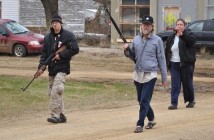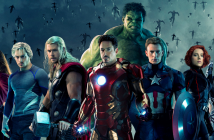Doctor, Lawyer, Indian Chief (2014)
Cast: Carlyle Edwards, Helen Bonaparte, Goodloe Byron
Director: Pablo D’Stair
Country: USA
Genre: Drama | Horror
Official Site: Here
Doctor, Lawyer, Indian Chief is writer and director Pablo D’Stair’s second film. He himself describes it as a “claustrophobic noir” in which “the lives of seven people are upended by coincidence, deceit, and paranoid assumption”.
The film opens with an argument between the main character, Leonard (Carlyle Edwards), and his wife Lana (Helen Bonaparte). They fight over a stranger, claiming to be Lana’s previous husband, which she denies without further interest in discussing this subject any longer. Her downplay and general behavior seem odd but it doesn’t take long to realize that she is not the only one to be having skeletons in her closet. Neither of them seems trustworthy or likeable during their introductory argument which is why the viewer finds himself in a state of uncertainty and disbelief.
Visually, Doctor, Lawyer, Indian Chief is quite similar to D’Stairs first film. Once again, it is presented in black and white and features unconventional camera work.
The narrative structure further encourages this feeling through its construction. It almost feels like D’Stair created a number of self-contained chapters as we follow Leonard meeting up with random people to discuss his personal issues. Although Doctor, Lawyer, Indian Chief features seven characters, none of them interact with each other, except for Leonard. He appears to be the only connection between those random people he meets up with. Yet with every sequence their actions and secrecy are further unraveled as we are slowly introduced to their background stories.
Visually, Doctor, Lawyer, Indian Chief is quite similar to D’Stairs first film. Once again, it is presented in black and white and features unconventional camera work. During the duration of the whole film, the camera remains completely steady with no movements at all, such as zoom or pans. Thus, D’Stair works heavily with changing perspectives and experimental angles, long sequences and very few cuts in between. With this, the camera functions as a quiet, distant observer. With low angle shots from the bottom of the floor, high angles shots from the corner of the ceiling or shots lurking from behind a wall, D’Stair creates the illusion of the character’s being under complete surveillance, adding to the sneaky and secretive atmosphere.
While Doctor, Lawyer, Indian Chief has a short running time of only 60 minutes, D’Stair is able to build suspense by keeping his viewers in the dark about the character’s motivations.
While Doctor, Lawyer, Indian Chief has a short running time of only 60 minutes, D’Stair is able to build suspense by keeping his viewers in the dark about the character’s motivations. This is mainly because of the narrative structure and the brief, but sufficient introduction of the protagonists and their intentions. The unconventional style in terms of cinematography functions as a recognition value of D’Stairs but often appears to be forcefully experimental. Nevertheless it makes up for the heavily over-theatrical acting, which marks the weakest spot of the noir.
Despite its flaws and some inconsistency, Doctor, Lawyer, Indian Chief provides a good script with an interesting approach of storytelling and further shows interest in a usual and offbeat cinematography.
Despite its flaws and some inconsistency, Doctor, Lawyer, Indian Chief provides a good script with an interesting approach of storytelling and further shows interest in a usual and offbeat cinematography.

![[Vimeo-]doctor lawyer.mp4_20140716_124824.579](../../../../wp-content/plugins/jquery-image-lazy-loading/images/grey.gif)


